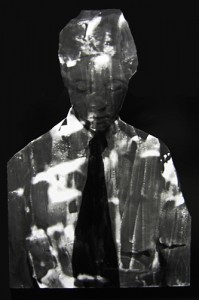Matt Saunders at Harris Lieberman
Matt Saunders has installed a multiplex of sorts at Harris Lieberman on Vandam Street and therein he is screening a restored homage to the lost cities of Weimar Germany. The geography of the gallery, as organized by Saunders, elicits the notion of the trawling, mobile spectator: partitions, columns, low podia, interior windows as screens doubling as walls create a fluid and reversible, while traversable, viewing space. The gallery’s geography works to redouble or mimic the fractured urban space of historical modernity: turn a corner behold a spectacle that is gone in a flash (well a flicker really).
The projected films and flat images are an assemblage of some known and some unidentified fragments and clips from deep within, though necessarily narrowly focused, sources from the cinematic cannon. Kuhle Wampe, the film written and partially directed by Bert Brecht in the early 1930’s plays strong in the flat images. Kuhle Wampe is a strangely un-Brechtian film in that it is so formally not strange. (Saunders installation is for sure more Brechtian than Brecht’s film). But Saunder’s show also creates a circumstance where one is sure one knows the images but cannot quite place them. Walther Ruttmann’s, Berlin Symphony of a great city, is, I swear, mined for some footage. And even if I am wrong and it is not Ruttmann’s great film that is quoted directly then that is still the neighborhood of cinema history being explored by Saunders.
Ruttmann’s film, and the genre it helped spawn, were of the historical moment wherein urban modernity and its various machine corollaries were sung about and too in tones of elaborate praise. Much ink as well as celluloid was spilled on this project and Saunders assuredly alludes to a cut-up of Benjamin and Krackauer’s work wherein modernity is a flicker show of fragments and moments. Indeed Saunders, somewhat lazily it could be thought, titles one of the pieces Passagework.
The projected films are a flicker-scape of often hard to decipher images that drift toward being unintelligible. In that, the flickering, the indecipherability, they are highly evocative of the specific historical moment I am referring to above. This is because in large part this is how that historical moment has come down to us; the flicker itself characterizes the experience of visual culture from the given moment. With this formal devise in hand, or in quotation marks, with the gallery space deployed as it is, and with the allusion to but non-identification of historical moments there is an inevitable sliding between dream, memory, history and fantasy. If film, in its predominant form, is transitive, i.e. it works to generate an end, a conclusion, then Suanders steers a course closer to cinema before the moment when that was its realized mission. Like Brecht and Ruttman Saunders is closer to avant-garde film. Closer to, in Tom Gunning’s term, a “cinema of attractions”, that is a cinema more kin to the midway attraction than to the novelistic tale. The urban corollary of this is, of course, the city itself as a pandemonium of attractions.
That Saunders wants to pore over history’s debris, albeit the well pored over debris of mid century Germany is exciting in its way. It is a glance, a long glance, given by much literature and cinema but far less so in the fine arts. In this Saunders has his nostalgic moments, fair enough; nostalgia is a tone or tense of memory. Strangely what is remembered, held nostalgically, is, of course, not Wiemar Germany (Saunders is a 30-something American living in Berlin in 2010) but Critical-Theory classes. The tone is one of cherishing Benjamin’s, Brecht’s, Krackauer’s or Ruttmann’s work. And this extends to the somewhat curious hand held out by Saunders across time to Herthe Theile. Theile, a German stage and screen actor of the Weimar period starred in Kuhle Wampe, from wherein Saunders borrows her image. But what is strange is the transformation she undergoes in the screening and filtering processes that Saunders uses to render her. There is something about the mannish, boyish military yet androgynous look of the shirt and tie. It evokes a Kit Kat club patron yes. (And Thielle was known for her lesbian roles and as being of the left.) But it is also in its way a Brownshirt image and as such a historical shorthand for German modernity’s collapse.
Part of what is happening here is that the formal strategies of Saunders, the old flickering silver screen, the new hybrid photograph-as-painting, add so many layers of gauze, so much Vaseline to the lens. They do not so much romanticize, as said devices have been coded to do, more they beget ambiguities. Slathering of this or that formal trick across the image imposes a haze which is also a –hmm, perhaps Brechtian– space for arguing the meaning. If one is going to gaze at the past’s images one must allow that there is a haze imposed upon us by history.
Old Brecht said it well!
Fog envelopes
The road
The poplars
The farms and
The artillery
Matt Saunders at Harris Lieberman
89 Vandam Street
NY NY 10013
212 206 1290






